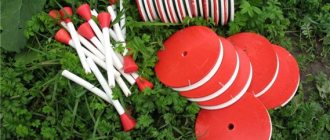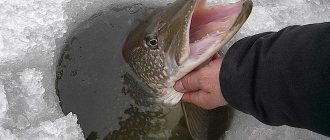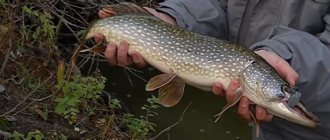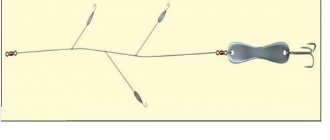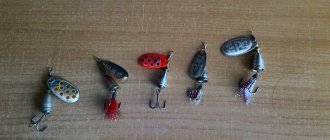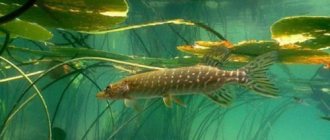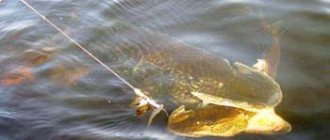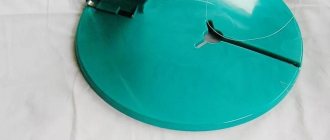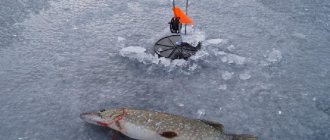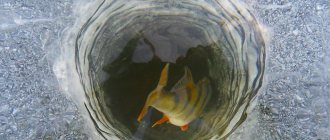Fishing for pike with the help of circles created with your own hands can show good results. And all this is thanks to the expansion of the total fishing area and the properties of the bait, which are characterized by seductiveness for a toothy predator.
To go on this kind of fishing, first prepare a boat, live bait and several mugs for pike. For a good catch, you need to try a little and prepare in advance.
What does the tackle look like?
In the classic version, the toothed circle is made in the form of a disk with a thickness of 25-30 mm and a diameter of 130-150 mm. It can be made of polystyrene foam or any type of wood.
There is a small groove running along the entire circumference of the rig (meaning the mug), designed to keep the monofilament in it. At the top of the disk plane there is a pair of slots. They are the ones who will hold the line after loading the tackle. In the center of the circle there is a special hole for a stick.
Even the color of the disc is unique. A layer of red or bright orange paint is placed on top, and white or black underneath. Of course, you can choose the colors yourself. But the main thing is to stick to contrast.
The circle mast or, in other words, the antenna is always created with a ball-shaped head and a thin end. Moreover, it is worth noting that it is recommended to make the mast and the disk the same in length. The thickness of the mast varies around 14 mm.
It is important to note that it is necessary to cut through the antenna in its thin part.
The thinner edge of the antenna is painted white, and the thicker edge is painted red. White and black stripes on the head of the pin, made vertically, will always allow you to observe the rotation of the equipment. Therefore, knowing this information, you will never miss a bite.
Disadvantages of store mugs:
- such mugs are excessively fragile and light;
- they are difficult to adjust;
- in store-bought mugs for pike, the hydrodynamics are not fully thought out , which is felt during the fishing process;
- they are not always convenient to use;
- It is the store equipment that requires improvement from its creators . Moreover, this concerns the essential points, not aesthetics.
How to properly equip a circle
The length of the entire fishing line on the circle is calculated by the formula: depth at the fishing site + 5-10 m, depending on the presence of thickets, snags and other natural obstacles nearby. Pike can tangle the tackle so much that you have to break it off. A steel or fluorocarbon leader is also not necessary, especially if the pike is inactive and there is a chance that pike perch and large perch might bite. The use of single, double or treble hooks depends on the type of bait fish available. A small gudgeon or brush can be attached to a single hook, but a white bream, crucian carp and silver bream can be attached to a double or tee hook.
Zywiec
Live bait should be chosen from those species of fish that are found in a given reservoir, but taking into account the fishing location and the expected size of the pike. When setting circles over significant depths away from thickets of reeds or reeds, the type of baitfish does not matter much, the main thing is to maintain the size. It should not exceed 10 cm, but sometimes, when there are no fry in the reservoir, larger live baits are also released.
When fishing for pike living among reeds or in thickets of grass, do not use loaches, loaches and crucian carp as live bait, because the tackle can become tangled. At the first opportunity, these types of fish will try to hide in the thickets, pulling the fishing line along with them. In such places it is better to use brushes, white breams, rudd or silver bream. Dace are especially good for this role. They do not like thickets, are quite hardy and very mobile.
Homemade circle for pike
Most fishermen make circles for catching toothy fish at their own discretion, so to speak, “for themselves.”
After all, it is experience and personal ideas about circle fishing that will allow you to create the equipment that is most convenient for you.
Optimal sizes
The optimal size for creating a circle is considered to be a disk thickness of 25-30 mm.
It is best to make its diameter five times longer – around 150 mm.
It is recommended to make the length of the stick the same as the height of the circle disk.
The thickness of the tackle is only 14 mm.
The process of making a tackle-mug with your own hands
The process of making a mug for catching toothy fish is not as simple as it might seem.
It is only in appearance that the equipment is simple and elementary. Its manufacture requires certain knowledge and subtleties of the matter, which will be discussed later.
Materials for making a mug
The most suitable materials for creating a circle are the following:
- linden, since it is best processed;
- foam propylene;
- polystyrene foam with fine grains;
- any other wood.
Making a mug
Experienced fishermen recommend using linden as a starting material for creating a circle for pike. It lends itself best to processing and can become a good tool. To ensure reliable holding of the antenna, it is necessary to cover the center with a round plug.
To prevent the disk from saturating with water, it is necessary to initially soak it with drying oil a couple of times. After that, you can start painting with paint, which must be waterproof. Only in this case the disc will not crack or deform during the fishing process.
It is for this reason that today fishermen do not use a board to make a toothy mug.
Moreover, in the absence of linden, you can create equipment from polystyrene foam or polypropylene foam. Although this raw material does not absorb water, it is difficult to paint.
Therefore, it has to be painted exclusively on top with bright paint, for example, red.
Even an ordinary tin can can be used in the form of a tool that will allow you to make a disk of the required circumference. It is important that the size suits you.
The top of the tin can is cut off. The workpiece is applied to the surface of the foam, pressed, and through several circular movements, the disk is squeezed out. The equipment is ready!
To create a trench in which the fishing line will be stored in the future, you don’t need to invent anything complicated. This is also the case when polystyrene foam is used as the starting material. Prepare a knife or triangular file.
Use these tools to cut out a small indentation and clean it out. This is for good movement of the monofilament in the recess.
Materials for making a mast
It is best to use a mug to create a mast:
- plastic;
- spruce;
- linden;
- pine
Making a mast
A special thickening is made at the bottom of the antenna.
It is designed to prevent the mast from passing through the hole and falling out.
A hole is made on the opposite edge of the stick.
Monofilament will be inserted into it in the future. This slot must have a certain size, more precisely, an average one.
Otherwise, the toothy one simply will not be able to pull out the fishing line or will pull it too far.
The middle of the mast circle is made in the shape of a cylinder. This is to ensure adjustment of its height above the disk and under different fishing conditions.
Making a classic foam mug
Today, there are many building materials that can be used to make fishing tackle for pike with your own hands, and their price is affordable for every angler. They can differ both in thickness and degree of porosity . The most popular type for making a mug is considered to be fine-pored foam 2 cm thick. A metal-plastic tube with a diameter of 1.5 cm is quite suitable for the pin.
- The basis of the mug for catching pike is a high-quality round polystyrene foam piece. But before you get started, it is advisable to make a template on cardboard or use a standard computer CD. To cut foam plastic, you can use a regular construction knife or jigsaw.
- The most difficult thing in making such gear is making a groove in the end part around the entire circumference. The depth of such a groove is usually 1 cm. To properly process the foam, it is better to use a knife or a round file. To make a hole in the center of the tackle, use a drill with a drill of the appropriate diameter slightly less than the thickness of the tube.
- To finish the disc, use fine-grain sandpaper. After cleaning the surface, it is opened with paint. In this case, the upper part should be bright, and the lower should contrast sharply with it. On the surface of the water, such a contrast will be striking even from a great distance.
- At the next stage, 2 cuts are made in the upper part of the circle for the fishing thread. Their location should be on opposite sides of the disk.
- At the final stage, a 12 cm piece of tube is cut off , in which they are made, washed down from the end side of the workpiece.
Equipment mug
The mug rig for catching toothy fish is lightweight and easy to use and manufacture.
The main parts of this type of equipment are:
- The disk of the circle, which has special notches to preserve the fishing line and a hole for the antenna;
- A stick with a hole for threading monofilament thread;
- Line with a diameter of 0.3-0.5 mm;
- Weight;
- Nozzle for further securing live bait;
- Leash.
fishing line
To equip a homemade circle, you must first prepare a fishing line with a diameter of 0.3-0.5 mm.
Moreover, you should definitely know the depth of the reservoir where you are going to fish. Since experts recommend making a small supply of monofilament.
So, it is advised to make the fishing line longer by 6-8 m from the depth of the fishing spot. Most often, 15-20 m of fishing line is completely enough.
In the case when catching a toothy predator will be done at great depths, it is recommended to attach a small piece of foam to the fishing line.
You can also use rubber. This will allow you to independently adjust the fishing depth.
Sinker and Hook
A sliding weight weighing 15 g is used as a sinker.
You can use any pike hook or treble hook. Here the opinions of experts and amateurs differ. But most often they decide to use a double hook.
Nozzle
Most often, circles are caught using live bait.
The best bait options for this method of fishing for toothy predators are:
- rudd;
- loach;
- ruff;
- perch;
- perched water;
- silver bream;
- rudd;
- gudgeon and much more.
How to catch pike with mugs
The main factors influencing successful and comfortable fishing with circle gear are weather conditions, the structure of the bottom topography, the type of flow and the intensity of overgrowth of the reservoir, as well as the activity of the predator. Weather conditions take first place in importance for good reason.
Important! A strong wind and the high wave that arises as a result of this phenomenon always impede this type of fishing, and other factors cannot compensate for this disadvantage, no matter how positive they may be.
When planning to place mugs on a pike, you need to take into account the strength of the wind and the possibility of placing rigs on the leeward side, otherwise fishing will look like a constant aimless pursuit of gear with little hope of its better installation. For fishing, it is better to plan calm, partly cloudy days. Fishing on the lake in summer with mugs is also possible using the power of a small wind, when the tackle is launched in its direction and followed by the boat on the boat, tracking the bites.
The best option for hunting would be to choose a shallow, slightly algae-free river backwater with virtually no current, where the gear can be installed without fear of its movement, not including, of course, the bite itself. Further in the course of the article, we will outline the nuances of fishing, which consist in choosing live bait, installing gear on an anchor and fishing techniques, focusing on the main points of fishing.
Which live bait to choose
The most effective pike bait looks like fish caught directly from the fishing spot. Such live bait material is clearly familiar to the predator and does not cause any suspicion in it, both from the point of visual perception and its movements. To catch live bait, the angler will need a fly rod or a lift, with which you can acquire live bait by catching it in the shallows and near bushes of small vegetation. As a rule, small crucian carp, roach, gudgeon, loach and roach are suitable for circle fishing. This type of fish is easy to catch and in terms of preservation, they differ from other fry in their relatively greater endurance. Fry are taken in sizes from 7 centimeters with a frisky disposition, which is more likely to attract a predator to attack.
Important! They mount the live bait under the gill, placing it vertically in the water horizon, trying not to hamper its movements with a short leash.
After six hours of unsuccessfully waiting for a bite, it is recommended to check the live bait for activity, changing it to a new, active specimen if necessary. If the bite is unsuccessful, it is better to replace the live bait that the predator has tried with a new one.
Anchor
In conditions of current or moderate wind, which blows gear away from a promising place, anglers use the method of anchoring a circle for pike fishing. This technique involves installing a blind weight at the end of the cord with the possibility of laying it on the bottom of the reservoir. Depending on this, the total amount of fishing line can be increased. At a distance calculated by the angler for successful catching of a predator, a rigid leash is tied to the main cord; it can be either steel wire or twisted fluorocarbon fishing line, 20–30 cm in size. The leash ends with the installation of a hook with live bait. The mounted tackle, due to the immobility of the load, will be anchored at a certain point and, regardless of the current and wind strength, will hold the bait in the right place.
Fishing and fishing techniques with mugs
The pike fishing mugs, worked out according to the design and equipment, are installed by the fisherman at promising points in the reservoir.
Important! Circle fishing is carried out using a boat.
The arrangement of equipment should allow for observation of installations from one point, trying not to disturb the predator with thoughtless swims and unnecessarily penetrations. Having tracked the bite, you should immediately move into the trigger zone, leaving the rest of the equipped mugs at a distance. The approach to the worked circle is done carefully, trying not to frighten the trophy with the oars. They select the foam disk itself, then begin to throw the released cord into the boat. Having felt the heaviness, they make a control hook, pulling the cord in their direction with adequate force. A caught fish immediately begins to resist, as a result of which the fishing line must be constantly kept taut, preventing the predator from moving.
Important! By pulling the trophy towards the boat, the force of the struggle will inevitably increase, which should be expected by first lowering the landing net into the water and trying to bring it under the caught fish.
The predator, thrown into the boat and freed from the hook, sits on the kukan and is kept on a short leash near the boat until the end of fishing.
DIY mugs for pike from a bottle
Sometimes there are situations when just relaxing in nature, a desire arises to go fishing. But there is no gear. There is no need to be sad. All issues can be resolved in half an hour.
Find a plastic bottle, preferably a half-liter bottle, and follow these guidelines:
- Wind a nylon thread onto an existing bottle , about five meters long, and secure it carefully. To do this, you can create a regular knot connection, use an elastic band or a lid.
- Fix the elastic band to the frame of the plastic bottle by creating several loops.
- Securely attach the tee with a sinker to the cord . This can be done either in front of the bottle or behind it.
- In principle, the equipment is ready . Now you just need to attach live bait and let the bait into the cavity of water. Moreover, it is necessary to regularly recheck your gear for the catch.
- If you wish, you have the opportunity to paint the bottle in some bright color. This will significantly increase the visibility of the equipment in the pond. And it is recommended to cover its lid with a waterproof product. This girder is effective for summer fishing. Whereas for the winter it is necessary to improve the tackle somewhat.
Features of fishing with mugs: fishing techniques and tactics
There are no specific features when fishing for pike with a circle, since this is the simplest and most effective method.
There is practically no need for the participation of the fisherman here; the main thing is to monitor the fluctuations of the circle and manage to drag the fish into the boat in time.
Often, many professional fishermen place as many circles around the boat as possible at different distances to increase fishing efficiency.
Choosing a place and time for catching pike with mugs
The key to an excellent bite will be the correct choice of place for fishing. You need to swim by boat almost to the very middle of the reservoir, since a large amount of algae and other underwater vegetation is constantly collected near the shores, which can make it difficult to catch pike with a circle.
IMPORTANT! Pike is a very picky predator, as it actively begins to bite only at certain hours, so you need to arrange your gear exactly according to the schedule.
The optimal time for arranging gear is from 4 to 6 am. At this time, the predator is as active and hungry as possible, so it goes out hunting for prey.
How to correctly place a circle on a pike?
Many novice fishermen set up their gear in such a way that the current carries it very close to the boat. For the bite to be productive, you need to move the circle with the current or in the direction of the wind. In this case, it will dangle on the waves and thereby vibrate the bait on the hook, which awakens the hunter’s instincts in the pike - and the fish swallows the bait.
Features of fishing for pike with a circle in summer and autumn
Many fishermen notice that the fall bite is very different from summer fishing. The whole point is that in the fall the algae begin to die off and rise closer to the surface of the water column, so you need to choose the minimum depth.
All fish that feed on vegetation rise higher to feast on algae, so the pike rises after the representatives of its food chain.
In summer, pike, on the contrary, drop as low as possible, since the water warms up greatly. In this case, you need to release the line from the circle to the maximum mark so that the load falls straight to the bottom. This method is also suitable for fishing in reservoirs where there is a strong current.
How to make a girder from a plastic bottle for winter fishing?
- Two empty plastic bottles are cut crosswise. Moreover, their shape must be different, and when measuring, one of them must be placed on the lower part of the other.
- Take an awl and create one hole in the bottle cap and two in its neck. This will be useful for tying fishing line later. It is also necessary to make a hole in the center of the bottom.
- Now you can start assembling the girder. Prepare your fishing line and cord in advance. The fishing line is threaded through the hole in the bottom of the bottle, and this way you will assemble the upper part of the vent.
- In order to ensure that the rope is suspended on a stick above the hole, it is necessary to create a loop on one of the edges of the fishing line, and a knot on the other.
- Connect the working line through the two holes. Having measured out the required amount, wrap it with a sinker and a tee.
- Then insert the lower part into the upper one and the equipment is ready!
The moment the predator grabs the bait, the bottom of the bait will definitely fly out from its top. In order not to get confused again later in assembling the equipment, it is better to mark the bottom and top of the bottle somehow, for example, paint it in different colors. This equipment will provide you with a catch at virtually no additional cost.
Happy fishing!
What kind of predator can you catch with a circle?
The most common catch of mug anglers is pike. It is caught both in large reservoirs and in lakes and ponds. On small rivers they usually place fixed mugs at anchor.
In deep reservoirs, it is often very successful to catch pike perch using circles, especially if the gear moves along the edge, which may be the bed of a flooded river and its banks. The main thing before fishing is to study the day's topography in the chosen place (about catching pike perch with a bait donkey or a bottle).
Mugs and their analogues - postavukhi - are used even in catching large carp, which sometimes cannot be caught with any tackle where a fishing rod is used. It will break. Therefore, the mugs are placed on a not very heavy anchor-weight and they wait for the carp to take and then drag the circle wherever their eyes look. Only when the fish gets tired do they take it off the hook.
Equipment for pike fishing circles
If a person has already dealt with fishing and is able to equip the same girder, then there will definitely not be any difficulties with the mugs. But for a beginner, this method of fishing can be difficult. However, manufacturers have provided for everything and mugs can be purchased either without equipment or completely ready for use.
Triple hook (HS-ST-36-5) Helios 24 for 1 pc. Tee ST36BN-No. 5 FORMIX 20 for 1 pc. Triple hook 974 No. 1 EAGLE CLAW 14 for 1 pc. Triple hooks “Sprut” Kawa ST-31 BC #2 (Treble Wide Gap Hook) 1pack*6pcs Sprut 380 for 1 pack. Triple hook ROUND (3R-BLN-01) METSUI 975 for 1 pack. Triple hook OWNER ST-46BC, No. 1 OWNER 19 for 1 pc. Triple hooks “Sprut” Hara ST-36 BC #4 (Treble Round Bend Hook) 1pack*7pcs Sprut 340 for 1 pack. Triple hooks Round Treble art. KH11030-02/1 Rubicon 520 for 1 pack. Tee HF-36 Needle point, #5 Hitfish 185 for 1 pack. Tee HF-36 Needle point, #4 Hitfish 185 for 1 pack.
Select a tee for circles
